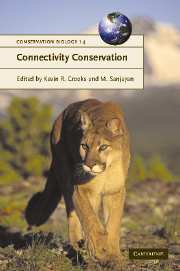Book contents
- Frontmatter
- Contents
- List of contributors
- Acknowledgements
- 1 Connectivity conservation: maintaining connections for nature
- PART I Approaches to connectivity research
- PART II Assessing connectivity
- PART III Challenges and implementation of connectivity conservation
- Introduction: Don't fence me in
- 18 Hyperconnectivity, invasive species, and the breakdown of barriers to dispersal
- 19 Disease and connectivity
- 20 Maintaining and restoring connectivity in landscapes fragmented by roads
- 21 Where to draw the line: integrating feasibility into connectivity planning
- 22 South Coast Missing Linkages: restoring connectivity to wildlands in the largest metropolitan area in the USA
- 23 Incorporating connectivity into broad-scale conservation planning
- 24 Escaping the minimalist trap: design and implementation of large-scale biodiversity corridors
- 25 The role of connectivity in Australian conservation
- 26 The future of connectivity conservation
- Index
- References
25 - The role of connectivity in Australian conservation
Published online by Cambridge University Press: 24 May 2010
- Frontmatter
- Contents
- List of contributors
- Acknowledgements
- 1 Connectivity conservation: maintaining connections for nature
- PART I Approaches to connectivity research
- PART II Assessing connectivity
- PART III Challenges and implementation of connectivity conservation
- Introduction: Don't fence me in
- 18 Hyperconnectivity, invasive species, and the breakdown of barriers to dispersal
- 19 Disease and connectivity
- 20 Maintaining and restoring connectivity in landscapes fragmented by roads
- 21 Where to draw the line: integrating feasibility into connectivity planning
- 22 South Coast Missing Linkages: restoring connectivity to wildlands in the largest metropolitan area in the USA
- 23 Incorporating connectivity into broad-scale conservation planning
- 24 Escaping the minimalist trap: design and implementation of large-scale biodiversity corridors
- 25 The role of connectivity in Australian conservation
- 26 The future of connectivity conservation
- Index
- References
Summary
INTRODUCTION
In Australia and globally, nature and society face a historically unprecedented wave of extinction and ecological degradation (Wilson 2002). Although large ecological reserves are an essential core component of any biodiversity conservation program, protected areas comprise only about 6–12% of the land globally (IUCN 2003) and nationally (Mackey et al. 2006) and are typically widely dispersed and isolated. This percentage of strictly protected land is too small – by a factor of five or ten, even if the reserves were optimally distributed (Soulé and Sanjayan 1998).
In response, critics of conventional conservation (e.g., Soulé and Terborgh 1999) often suggest that long-term prospects for biodiversity will be enhanced the more the entire landscape, irrespective of tenure, is managed as a conservation (rather than a production) matrix. Such a transformation, however, will demand a bolder and more systematic approach to nature protection. This will require increases in the area protected, enhanced biotic and abiotic connections between core protected habitat areas, and reconsideration of the economic and recreational activities on lands where native ecosystems still dominate.
In North America and elsewhere, it has been recognized that existing conservation initiatives fail to provide sufficient area and ecological connectivity to accommodate the key, large-scale, long-term ecological processes necessary to sustain natural systems (Soulé and Terborgh 1999; this volume). Neither do they allow for evolutionary adaptation to environmental change. The current situation for biodiversity in Australia is similar (Australian Government 2001).
- Type
- Chapter
- Information
- Connectivity Conservation , pp. 649 - 675Publisher: Cambridge University PressPrint publication year: 2006
References
- 5
- Cited by



